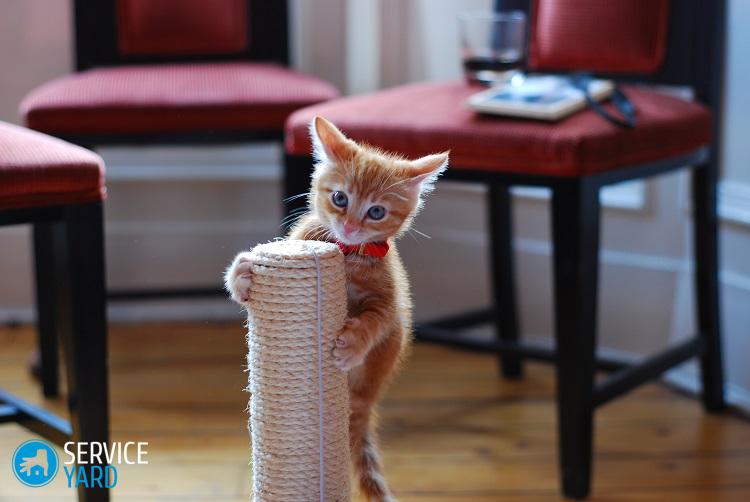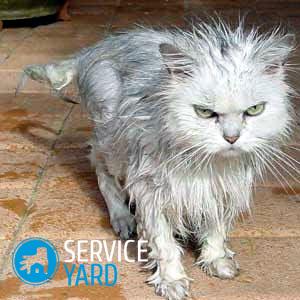How to make a cat scratching post?

Ripped wallpaper, deplorable appearance of carpets and upholstered furniture - all this is the matter of sharp claws of pets. However, one should not think that they do this out of harm. Claw grinding is an instinct that allows a predator to survive in the wild. And although homemade Murka is much inferior in size to her cousins - lions, panthers and tigers, her habits are much similar. And domestication has nothing to do with it. In nature, the beast uses trees to grind its claws. Let's talk about how to make a cat scratching post for a cat yourself. This is not difficult at all, and the furniture will be in perfect order.
to contents ↑Why is this necessary?
The process of growth of claws in cats, whether it is a tiger, manul or domestic Murzik, is fast enough. If you do not grind them on a hard surface, they grow into the body, causing the animal great discomfort. Naturally, the trees of the house do not grow, so you need to buy a “claw rail” at the pet store or do it yourself yourself as soon as possible. Otherwise, you will constantly think that the cat is pulling furniture and wallpapers, what to do with it.
to contents ↑Important! Scolding a “non-disciplined” cat, spraying it with water from a spray bottle or even more so beating is completely useless. Instinct from this will not be lost, and relations with the animal will be ruined.
Requirements
Before you make a cat scratching post for a cat at home, you need to determine the requirements that it must necessarily meet:
- Sustainability. In any case, the product must support the weight of the pet, even if we are talking about such large breeds as the Persian, Angora, and especially Maine Coon.
- Compactness. Own space for a fluffy (or not too) favorite is wonderful, but in most cases you have to proceed from the realities of a small apartment. Cluttering up a tiny room with a multi-tiered whatnot for a cat, even if he is pulling furniture and wallpaper, is at least unreasonable and irrational. Therefore, the ideal option if the claw point has small dimensions.
- Durability. You probably already had to see what the furniture turns into after a “cat manicure”? Draw conclusions.
- Aesthetics. For the animal to pay attention to the product, you need to place it in the public domain for the cat. Therefore, “claw-dog” automatically becomes an element of the interior. She may not beautify the situation, but she certainly should not mutilate her.
to contents ↑Important! Distinguish between horizontal and vertical devices. The choice of a particular option depends on the taste of the owner and on how exactly the pet is used to grinding its claws. To do this, it is enough to observe what gets more: the armrests of the chairs, carpet or wallpaper.
Cat scratching post - materials for making
So, to make a cat scratching post, for successful work you will need:
- A block of wood 0.5-0.7 m long. These are approximately two body lengths of your pet (not counting the tail). The square side of the bar is 50-60 mm.
- Twine from hemp or jute with a diameter of 4-7 mm. You do not need to measure the length in advance, just purchase 2 ready-made skeins in the store. If this is not enough, you can always buy extra.
Important! Don't want to mess with the twine? You can use carpet with a hard surface for a homemade scabbard.
- Board or plywood for the manufacture of the base. The base is a square of 400x400 mm. Its thickness varies between 1.5 and 2.0 cm.
- To finish the base, you can use faux fur, tapestry or any furniture textiles. The amount of finishing material is chosen so that it covers the base in the upper part and on the sides. A little of the same material will be needed to close the beam from above.
Important! Do not use cellulose twine to make claws. It is fragile, you will often have to change it. In addition, cellulose, getting inside, can harm the pet.
In addition to materials, you will need:
- Wood glue.
- Self-tapping screws.
- Screwdriver.
- Jigsaw (it can be replaced with a hacksaw).
to contents ↑Important! Depending on what kind of breed your pet is, our master classes may also be useful to you:
DIY nails for a cat - procedure
Saw out all the details for the claw point to the dimensions shown. After all the blanks are available, proceed to work:
- Wrap the twine on the bar, smearing it with glue every 10 cm. Gluing will fix the twine much stronger. After you have reached the end of the bar, glue the last two turns.
- Apply glue to the top of the timber, cover it with a piece of furniture cloth or faux fur. Trim excess material.
- Glue the fabric to the base. Cut a hole in the center of the piece of cloth slightly smaller than the length of the side of the bar. You can prepare it in advance.
Important! Often, clawpaws look like real mini-complexes for cats. If you manage to independently carry out the simplest option, you can make something creative.
- Attach the bar to the base with self-tapping screws. Check it for stability. If the base is not too resistant, make it heavier with a load.
Important! When keeping such furry pets at home, it is very important to pay attention to their cleanliness. Check out our selection of tips and tools to help you if necessary. wash the cat if there is no special shampoo.
So, it remains only to wait for the pet to appreciate your efforts. If you do not want to mess with the bar, try the option with a plywood scratching post at home. Paste it with a rope, beat it to the wall or place it on the floor.
to contents ↑Important! If you find a claw of a pet near the “claw-dog”, do not be alarmed - this is completely normal. Instead of the old, obsolete plate, a new one will soon grow.
Cardboard construction
A hand-made clawboard made of cardboard is suitable for small kittens or small and dwarf breeds with weak paws (munchkins or elves). For large animals, this option is not suitable, and they will quickly take up the old.
Strips of material can be glued in different ways - in the form of a wave or a spiral. You can make an elegant corner product.
to contents ↑Important! So that your pet does not show his displeasure, because these pussies are very neat and picky, and you were more comfortable in your home, find out:
Some interesting claw-claw ideas
The fantasy of home craftsmen is truly endless, especially when the cat is pulling furniture and wallpaper and you need to do something about it. Therefore, they create real works of art for their pets:
- Mat. It is convenient to place, and it looks great. The same rug can be made in the form of “sea wave”. He will look even more attractive.
- Ottoman. Multifunctional product that fits perfectly into the interior of the hallway or bedroom.
- Cat-shaped dog-shaped. Finally, your domestic beast will take revenge on its eternal enemy, and with complete impunity.
- Do-it-yourself multi-tiered clawing point is an option for families with several seals.
How to explain to the cat a place for manicure?
So, you put all your skill and diligence into the manufacture of the scratching post. And the pet does not even think of abandoning addictions. He pretends to be a wild manul or an Amur tiger, tears upholstered furniture and wallpapers, only shreds fly. The answer is one: the cat is not to blame. She simply does not understand why this strange object is intended, for which the owner slammed his entire day off. We'll have to explain to the beast what’s what.
Do not use catnip or valerian to attract catnip. These substances can attract the attention of an animal, but, to put it mildly, not very useful. You can use a special tool from a pet store, but it costs a lot. There is another tool, completely free:
- Rub the tattered area with a clean soft cloth. Then rub the “working” surface of the claw point with the same cloth.
- Grease the previous place for “manicure” with a solution of dishwashing liquid with an extract of orange or lemon. For humans, this is a pleasant smell, and for cats - an unbearable stink.
- Bring the mustachioed to the do-it-yourself claw-claw. Run your feet over the surface several times.
Stock footage
Of course, the cat will not understand everything at once and will try to return to the usual place. But the unpleasant (in the cat's coordinate system) smell will not allow this. A little patience, tricks, and you will succeed - you will forget that the cat was tearing furniture and wallpapers!
















